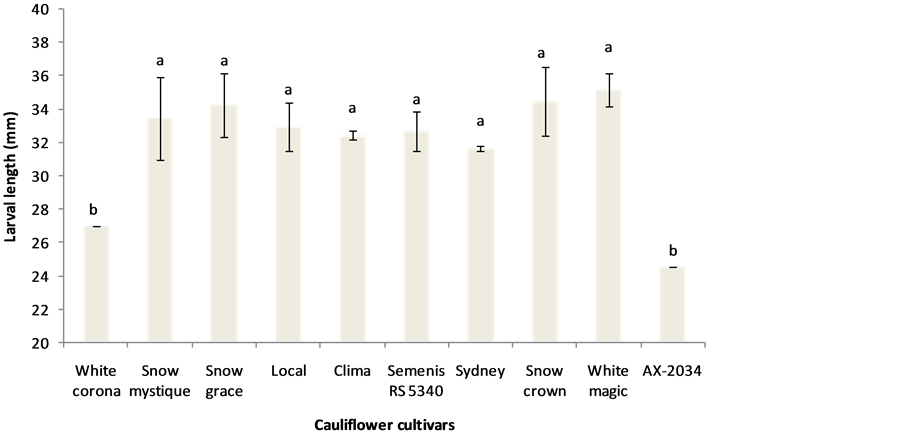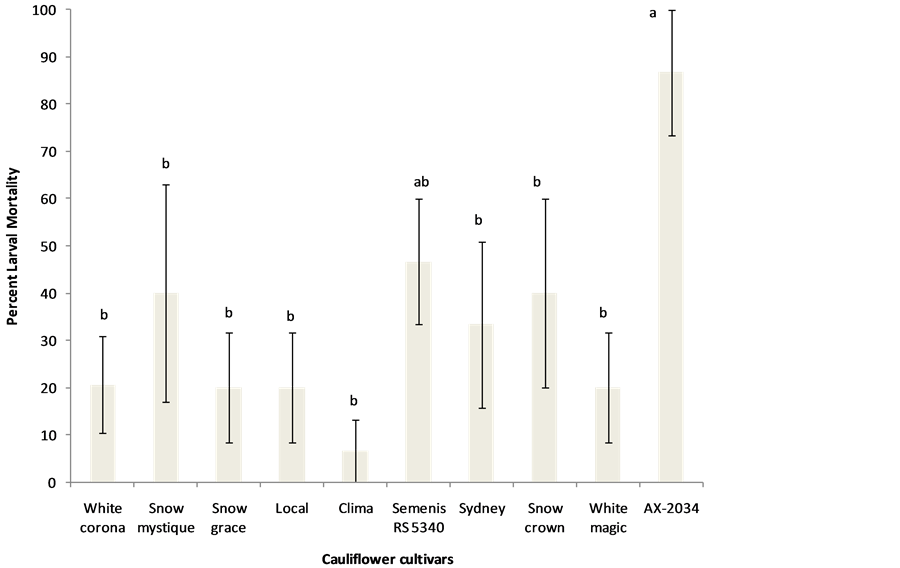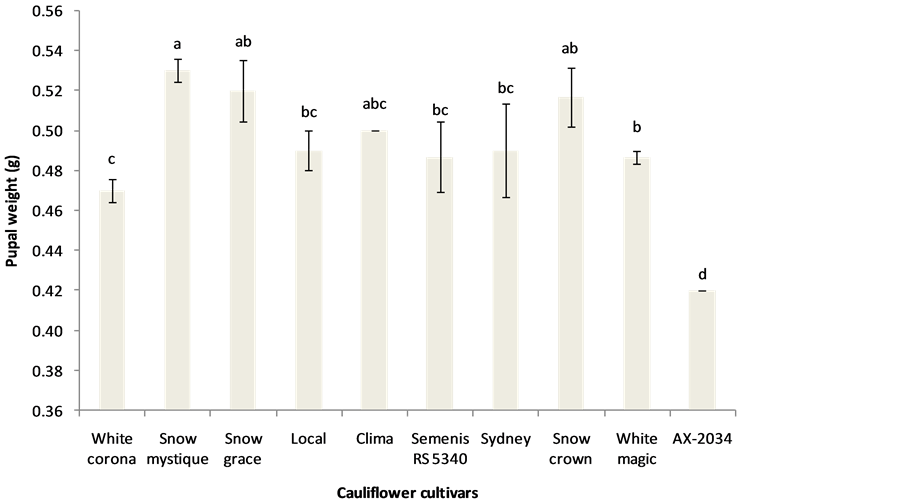American Journal of Plant Sciences
Vol.5 No.18(2014), Article
ID:48578,6
pages
DOI:10.4236/ajps.2014.518275
Developmental Response of Pieris brassicae (L.) (Lepidoptera: Pieridae) on Different Cauliflower Cultivars under Laboratory Conditions
Amna Sadozai, Imtiaz Ali Khan
Entomology Department, Faculty of Crop Protection, The University of Agriculture, Peshawar, Pakistan
Email: amnasadozai@yahoo.com
Copyright © 2014 by authors and Scientific Research Publishing Inc.
This work is licensed under the Creative Commons Attribution International License (CC BY).
http://creativecommons.org/licenses/by/4.0/



Received 7 May 2014; revised 19 June 2014; accepted 26 July 2014
ABSTRACT
Cauliflower is popular vegetable in Pakistan and it is severely attacked by Pieris brassicae (L). There are different cauliflower cultivars available in this area. The aim of this study was to determine the developmental response of Pieris brassicae on ten cauliflower cultivars. An experiment was conducted during 2012-13 at the Entomology section of the Agriculture Research Institute Tarnab Peshawar under laboratory conditions of 20˚C ± 2˚C, 50% ± 5% RH and 12:12h photoperiod. Pieris brassicae eggs were collected from a cauliflower field ARI Tarnab and the larvae placed after hatching on fresh leaves often cauliflower cultivars. The results showed that the larval development of P. brassicae was short (35 days), longer larval length (32.41 mm), larval mortality was low (6.6%) and pupal weight was high (0.50 g) on Clima cultivar. On the other hand, a longer larval developmental period (37 days), higher larval mortality (86.66%), shorter larval length (24.55 mm) and lower pupal weight (0.42 g) were recorded on cultivar AX-2034.
Keywords:Pieris brassicae, Biology, Cauliflower

1. Introduction
Cauliflower (Brassica oleracea), one of the vegetables in the family Brassicaceae, produces flowers once a year and relies on seeds for new plant generation. Typically, only the head (the white curd) of aborted floral meristems is eaten, while the stalk and surrounding thick, green leaves are used in vegetable broth or discarded [1] . In the Peshawar valley the cauliflower crop is attacked by a number of insect pests at different stages of development, which results in considerable reduction in yield. In order to get maximum yield, excessive use of insecticides is made. Insect pests of cauliflower include the Cabbage butterfly, cutworms and aphids. The Cabbage butterfly (Pieris brassicae L.) is also a serious pest of other cruciferous vegetables like cabbage and radish [2] . Pieris brassicae originates from Europe. It infests 91 species of plants from 12 families in the wild [3] .
The host range of P. brassicae among cruciferous plants is turnip, cauliflower, cabbage white and colored cabbage especially, and radish. P. brassicae occurs also on nasturtium, onions, mignonette, capers, and hedge garlic [4] .
The host plants significantly affect the life history of P. brassicae. It affects the survival rate of developmental stages, sex ratio, and oviposition period [5] . The overall developmental period of P. brassicae larvae under both laboratory and field conditions was significantly higher on yellow sarson (38 to 43 and 36 to 40 days) and lower on cabbage (32.35 to 35.95 and 31.17 to 35.07 days). Furthermore, P. brassicae had the highest generation mortality on yellow sarson (0.3565 and 0.3645) and lowest on cabbage (0.2555 and 0.2486) under laboratory and field conditions [6] . The highest net reproductive rate (R0) of 27.1 occurred on cauliflower followed by cabbage 24.89 [5] .
Economic damage occurs when the percent of destroyed leaf area reaches 3.97 - 10.41 in early cabbage, 10.75 - 13.76 in late cabbage, 13.80 - 16.89 in early cauliflower and 7.79 - 9.63 in late cauliflower [2] . Feeding behavior of P. brassicae larvae under laboratory conditions showed that the larvae strongly preferred Brassica oleracea as compared to Raphanus sativus and Lycopersicon esculentum [7] . Tropaeolum majus and Armoracia rusticana were found to be the most unsuitable host plants for P. brassicae larvae; these caused high mortality in the larvae and hibernating pupae [8] .
In the current study, presently commercially available cauliflower cultivars were studied for the developmental response of P. brassicae on them under laboratory conditions in a quest to find resistant cultivars of cauliflower.
2. Materials and Methods
The experiment was conducted during 2012-13 at the Entomology section of the Agriculture Research Institute Tarnab, Peshawar under laboratory conditions of 20˚C ± 2˚C, 50% ± 5% RH and 12:12h photoperiod. The eggs of P. brassicae along with leaves were collected from Cauliflower field ARI Tarnab. Ten newly hatched instar larvae were transferred to separate plastic jars (medium size) with leaves of ten cauliflower cultivars, namely White corona, Snow mystique, Snow grace, Local, Clima, Semenis RS 5340, Sydney, Snow crown, White magic and AX-2034. Leaves of all the varieties were daily fed to the larvae. The jars were cleaned of excrement and food residue every day. The mouths of jars were covered by muslin cloth so that no larvae could escape. The experiment was laid out in Completely Randomized Design (CRD) with three replications.
3. Data Collection
Data for the larval developmental period (days), larval mortality (%), full grown larval length (mm) and pupal weight (g) were recorded. The length of full grown larvae was determined using a vernire caliper. The pupae were weighed on an analytical scale, where a pupae was placed in a closed weighing chamber during weighing.
Data were analyzed by ANOVA, the means were compared by LSD test, at significance level of P < 0.05.
4. Results and Discussion
The results showed no significant difference (P-value = 0.05) in the larval developmental period of P. brassicae fed on various cauliflower varieties (Figure 1). Minimum larval developmental period (34.00 days) was recorded on the Snow grace variety and maximum (37.66 days) on Snow crown. The total development period of P. brassicae was a maximum on B. rapa (69.92 ± 0.61 days) and a minimum on B. carinata (61.95 ± 0.45 days) respectively [9] . The total development period ranges from 32 - 64 days over three generations [10] . P. brassicae completes its generation in 40 days on cabbage, cauliflower and broccoli [5] . While none of the cultivars was found immune to P. brassicae. The cultivars were graded into different categories of resistance based on the population of caterpillars per plant [11] . P. brassicae preference on various Brassica genotypes (CON-III, Cyclone, CCS-01 Oscar, SPS-5, K.S-75 and CON-II). Pieris brassicae showed the lowest preference to CON-II

Figure 1. Pieris brassicae larval developmental period (days) on ten cauliflower cultivars. Bar heads with similar letters are not significantly different from each other at the 5% level of significance.
and highest to Brassicae genotype cyclone [12] . This study also reported that as the pest showed varied preference to different Brassica genotypes, which might be helpful in developing resistant Brassica cultivars against P. brassicae.
The results of P. brassicae larval length revealed significant differences among various treatments. Larval length of P. brassicae was significantly lower on AX-2034 (24.55 mm) and White corona (27 mm) and higher (35.13 mm) on White magic (Figure 2). Larval stage of P. brassicae is the important in determining the fecundity of the adults. During last larval instar food is stored in the body and increases its body mass. In case of poor feeding conditions or unfavorable food the larvae have a smaller body mass than normal [8] . Our study is in agreement with a laboratory study of [13] whose results showed that the average length and breadth of fifth instar larvae were39.74 ± 1.98 mm and 4.12 ± 0.22 mm respectively.
Larval mortality of P. brassicae was the significantly the highest on AX-2034 (86.66%) followed by Semeins RS 5340 (46.66%), Snow mystique (40%), Snow crown (40%), Sydney (33.3%), White corona (20.66%) and (20%) Snow grace, White magic and Local cultivar while the lowest mortality was recorded on Clima (6.60%) (Figure 3). While the most unfavorable hosts for P. brassicae were horse-radish and nasturtium which caused 100% and 71% mortality, respectively [8] . Larval mortality depends upon the different cultivars of cabbage. While no considerable differences in the development period of P. brassicae larvae on different cultivars was observed [14] .
In this study pupal weight of P. brassicae varied significantly among the various cauliflower cultivars. It was significantly lower on AX-2034 (0.42 g) as well as White corona (0.47 g) but higher on Snow mystique (0.53 g), Snow grace (0.52 g), Clima (0.50 g) and Snow crown (0.51 g) as shown in Figure 4. While highest pupal weight recorded on kale (440 mg), followed by podarok (390 mg), red cabbage (376 mg), cauliflower (374 mg), rutabaga (349 mg), Brussel sprouts (347 mg), nasturtium (345 mg) and horse-radish (332 mg) [8] . While maximum pupal weight of P. brassicae recorded on white cabbage (319.7 mg), followed by cauliflower (303.7 mg) and red cabbage (272.8 mg) [15] . Moreover, P. brassicae pupal weight is directly dependent on reserves stored at the larval stage and pupae with small weight appear when growing conditions at the larval stage were unfavorable [7] . In the present study, the larvae were provided with sufficient amounts of cauliflower leaves under optimum growing conditions and so the differences in pupal weights reflect the different nutritional values of cauliflower varieties.

Figure 2. Pieris brassicae larval length (mm) on ten cauliflower cultivars. Bar heads with different letters are significantly different from each other at 5% level of significance.

Figure 3. Pieris brassicae larval mortality (%) on ten cauliflower cultivars. Bar heads with different letters are significantly different from each other at 5% level of significance.
5. Conclusion
Our results show that the larval developmental period of P. brassicae on all ten cauliflower cultivars commercially available in Khyber Pakhtunkhaw is similar and they proved susceptible to P. brassicae under laboratory conditions. Therefore growers of cauliflower cannot rely on resistant plants for the control of P. brassicae. There is a need for an integrated management program which combines different strategies under field conditions to control this insect.

Figure 4. Pieris brassicae pupal weight (g) on ten cauliflower cultivars. Bar heads with different letters are significantly different from each other at 5% level of significance.
Acknowledgements
This study is a part of PhD Dissertation Research and was sponsored by Higher Education Commission, Islamabad which is greatly acknowledged.
References
- Sharma, S.R., Singh P.K., Chable and Tripathi, V. (2004) A Review of Hybrid Cauliflower Development. Journal of New Seeds, 6, 151-159. http://dx.doi.org/10.1300/J153v06n02_08
- Jogar, K., Metspalu, L., Heiisaar, K., Luik, A., Martin, A.J., Mand, M., Jaaniso, R. and Kuusik, A. (2005) Physiology of Diapause in Pupae of Pieris brassicae L. (Lepidoptera: Pieridae). Agronomy Research, 3, 21-37.
- Someya, H., Takano, S., Tatematsu, Y., Hayase, T., Kawabata, J. and Imamura, T. (2007) Effects of Some Insecticides on Mortality of Pieris brassicae (Linnaeus) (Lepidoptera: Pieridae). Research Bulletin of the Plant Protection Service, 43, 33-35.
- Ovsyannikova, E.I. and Grichanov, I.YA. (2009) Interactive Agricultural Ecological Atlas of Russia and Neighboring Countries. Economic Plants and their Diseases, Pests and Weeds. http://www.agroatlas.ru
- Hasan, F. and Ansari, M.S. (2010) Effect of Different Cole Crops on the Biological Parameters of Pieris brassicae (L.) (Lepidoptera: Pieridae) under Laboratory Conditions. Journal of Crop Science and Biotechnology, 13, 195-202. http://dx.doi.org/10.1007/s12892-010-0025-2
- Arshad, A. and Rizvi, P.Q. (2007) Developmental Response of Cabbage Butterfly, Pieris brassicae L. (Lepidoptera: Pieridae) on Different Cole Crops under Laboratory and Field Conditions. Asian Journal of Plant Sciences, 6, 12-41.
- Rather, A.H. and Azim, M.N. (2009) Feeding Response in Pieris brassicae Larvae to Host/Non-Host Plants. World Journal of Agricultural Sciences, 5, 143-145.
- Metspalu, L., Hiiesaar K., Joudu J. and Kuusik A. (2003) Influence of Food on the Growth, Development and Hibernation of large White Butterfly (Pieris brassicae). Agronomy Research, 1, 85-92.
- Chahil, G.S. and Kular, J.S. (2013) Biology of Pieris brassicae on Different Brassica Species in the Plain of Punjab. Journal of Plant Protection Research, 53, 53-59.
- Sood A.K. and Bhalla, O.P. (1996) Ecological Studies on the Cabbage White Butterfly in the Mid-Hills of Himachal Pradesh. Journal of Insect Science, 9, 122-125.
- Lal, O.P. (1991) Studies on Field Resistance of Different Cultivars and Crosses of Cabbage against Cabbage Caterpillar, Pieris brassicae (L). (Lepidoptera: Pieridae). Zeitschrift füer Pflanzenkrankheiten und Pflanzenschutz, 98, 293-300.
- Aslam, M.N., Aslam, M. and Shaheen, F.A. (2000) Preference of Pieris brassicae (Linnaeus) (Lepidoptera, Pieridae) on Different Brassica Genotypes under Field Conditions. Pakistan Journal of Biological Sciences, 3, 1339-1340. http://dx.doi.org/10.3923/pjbs.2000.1339.1340
- Bhubaneshawari, M., Kananbala, A., Joymati, L., Ronikumar, L. and Binarani, A. (2012) Morphometric Measurement of Cabbage Butterfly Pieris brassicae(L.) (Lepidoptera: Pieridae) in the Agro-Ecosystem of Manipur. International Journal of Basic and Applied Medical Sciences, 2, 31-33.
- Chandra, J. and Lal, O.P. (1976) Development and Survival of Caterpillars of Cabbage Butterfly, Pieris brassicae Linn. on Some Varieties of Cabbage. Indian Journal of Entomology, 38, 187-188.
- Shternshis, M.V., Andreeva, I.V. and Shatalova, E.I. (2012) The Influence of Host Plants on Herbivore Community Composition on Brassica Crops in Western Siberia. ISRN Botany, 2012, Article ID: 682474. http://dx.doi.org/10.5402/2012/682474

